A : The resting heart rate, about 75/minutes, usually is lower than the autorhythmic rate of the SA node (90 - 100 beats/minute).
R : At rest condition, the parasymphathetic effects dominate.
If both Assertion & Reason are true and the reason is the correct explanation of the assertion, then mark (1).
If both Assertion & Reason are true but the reason is not the correct explanation of the assertion, then mark (2).
If Assertion is true statement but Reason is false, then mark (3).
If both Assertion and Reason are false statements, then mark (4).
The correct Answer is:A
Step-by-Step Solution:
1. Understanding the Assertion (A):
- The assertion states that the resting heart rate is about 75 beats per minute, which is lower than the autorhythmic rate of the SA node, which is typically between 90 to 100 beats per minute.
- This indicates that the heart does not beat at its maximum capacity when at rest.
2. Understanding the Reason (R):
- The reason provided states that at rest, the parasympathetic effects dominate.
- The parasympathetic nervous system is responsible for slowing down the heart rate and promoting a state of rest and relaxation.
3. Connecting A and R:
- The lower resting heart rate (75 beats per minute) compared to the SA node's autorhythmic rate (90-100 beats per minute) can be attributed to the influence of the parasympathetic nervous system.
- The vagus nerve, which is part of the parasympathetic system, innervates the SA node and reduces the heart rate during resting conditions.
4. Conclusion:
- Since both the assertion and the reason are true, and the reason explains the assertion, we can conclude that both statements are correct and that the reason is the current explanation for the assertion.
5. Final Answer:
- The correct option is 1, which states that both the assertion and reason are true, and the reason is the current explanation for the assertion.
- The assertion states that the resting heart rate is about 75 beats per minute, which is lower than the autorhythmic rate of the SA node, which is typically between 90 to 100 beats per minute.
- This indicates that the heart does not beat at its maximum capacity when at rest.
- The reason provided states that at rest, the parasympathetic effects dominate.
- The parasympathetic nervous system is responsible for slowing down the heart rate and promoting a state of rest and relaxation.
- The lower resting heart rate (75 beats per minute) compared to the SA node's autorhythmic rate (90-100 beats per minute) can be attributed to the influence of the parasympathetic nervous system.
- The vagus nerve, which is part of the parasympathetic system, innervates the SA node and reduces the heart rate during resting conditions.
- Since both the assertion and the reason are true, and the reason explains the assertion, we can conclude that both statements are correct and that the reason is the current explanation for the assertion.
- The correct option is 1, which states that both the assertion and reason are true, and the reason is the current explanation for the assertion.
Topper's Solved these Questions
- BODY FLUIDS AND CIRCULATIONBook:AAKASH INSTITUTE ENGLISHChapter:BODY FLUIDS AND CIRCULATIONExercise:Assignment Section - C Previous Year Questions
Explore 69 Videos
- BIOTECHNOLOGY-PRINCIPLES AND PROCESSESBook:AAKASH INSTITUTE ENGLISHChapter:BIOTECHNOLOGY-PRINCIPLES AND PROCESSESExercise:ASSIGNMENT SECTION-D (Assertion-Reason Type Question)
Explore 10 Videos
- BREATHING AND EXCHANGE OF GASES Book:AAKASH INSTITUTE ENGLISHChapter:BREATHING AND EXCHANGE OF GASES Exercise:ASSIGNMENT SECTION - D
Explore 11 Videos
Similar Questions
The rate of heart beat per minute is highest in case of
View SolutionThe following diagram is what a nurse saw on a patient's ECG trace, which measures the electrical impulse passed by the heart in one heartbeat. The first arrow on the left signifies the beginning of the beat and the second arrow on the right signifies the end of the beat
How many beats per minute did the nurse find in this patient?
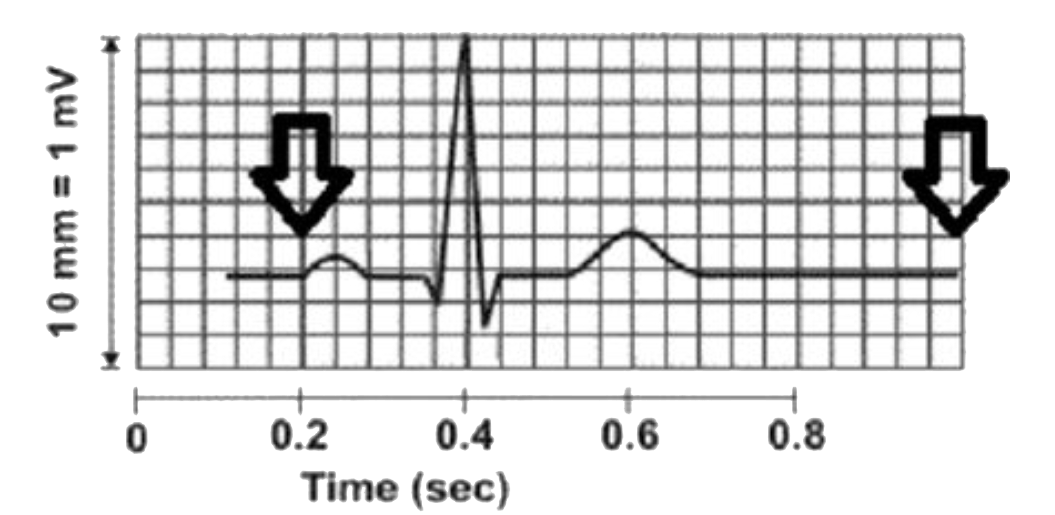
(a) 100
(b) 75
(c) 60
(d) 54
View Solution
Knowledge Check
When there are x milligrams of a certain drug in a patient's bloodstream, a patient's heart rate, h, in beats per minute, can be modeled by the equation h=60+0.5x. Which statements are true?
I. 10 minutes after taking the drug, the patient's heart rate increase to 75 beats per minute.
II. When the drug is not in the bloodstream, the patient's heart rate is 70 beats per minute.
III. For each 10 milligram increase of the drug in the patient's bloodstream, the patient's heartbeat increase 5 beats per minute.AI and IIBI and IIICII and IIIDI, II, and III
Ten 25 - years - old men were asked how many hours per week they exercise and their resting heart rate was taken in beats per minute (BPM). The results are shown as points in the scatterplot above, and the line of best fit is drawn. What is the resting heart rate, in BPM, of the men represented by the data point that is farthest from the line of best fit?A60B66C67D75Ten 25- year - old men were asked how many hours per week they exercise and their resting heart rate was taken in beats per minute (BPM). The results are shown as points in the scatterplot below, and the line of best fit is drawn.
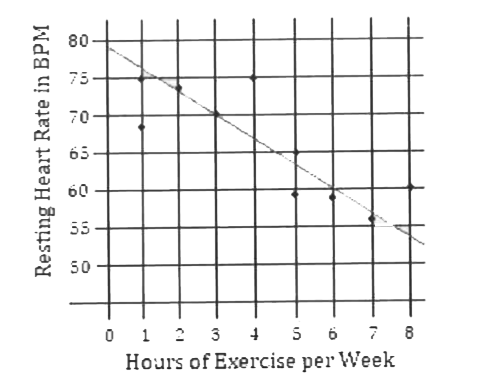
Based on the line of best fit, what is hte predicted resting heart rate for someone that exercises three and a half hours per week?A66 BPMB68 BPMC70 BPMD72 BPM
A ladder 10 metres long rests with one end against a vertical wall, the other on the floor. The lower end moves away from the wall at the rate of 2 metres/minute. The rate at which the upper end falls when its base is 6 metres away from the wall
View SolutionA certain drug raises a patient's heart rate, h, in beats per minute, according to the equation h(x)=65+0.2x, where x is the number of milligrams of the drug in the patient's bloodstream. After t hours, the level of the drug in the patient's bloodsteam decrease exponentially according to the equation x(t)=512(0.7)t. After 5 hours, what is the number of beats per minute in the patient's heart rate, correct to the nearest whole number?
View SolutionTen 25- year - old men were asked how many hours per week they exercise and their resting heart rate was taken in beats per minute (BPM). The results are shown as points in the scatterplot below, and the line of best fit is drawn.
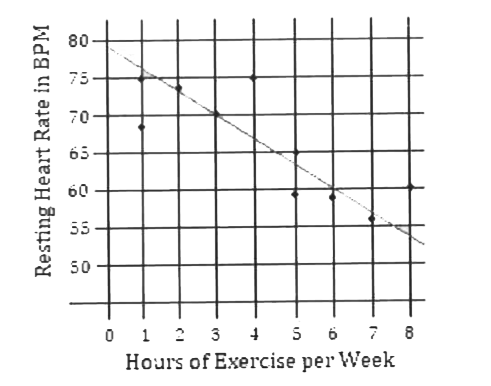
Which of the following is the best interpretation of the slope of the line of best fit in the context of this problem?
View SolutionTen 25- year - old men were asked how many hours per week they exercise and their resting heart rate was taken in beats per minute (BPM). The results are shown as points in the scatterplot below, and the line of best fit is drawn.
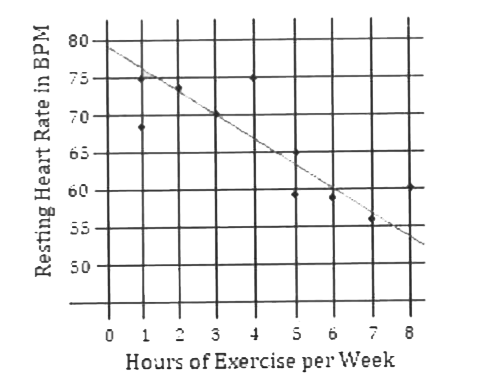
How many of hte men have a resting heart rate that differs by more than 5 BPM from the resting heart rate predicted by the line of best fit?
View Solution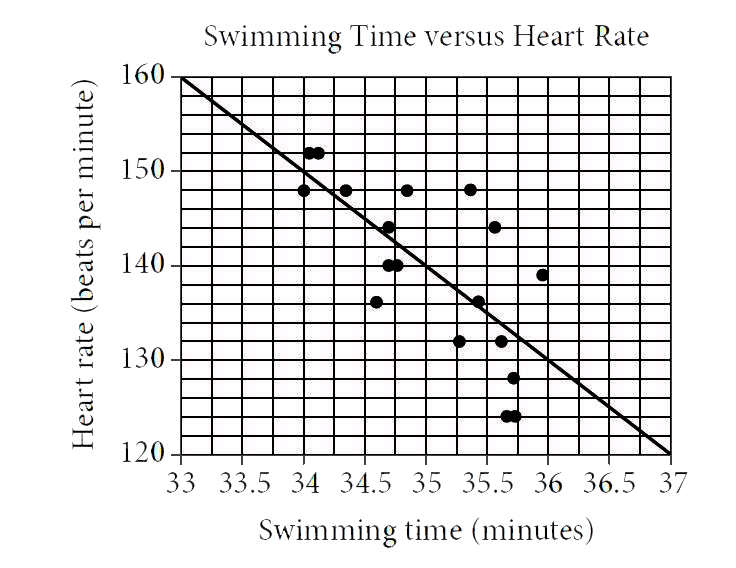
Michael swam 2,000 yards on each of eighteen days. The scatterplot above shows his swim time for and corresponding heart rate after each swim. The line of best fit for the data is also shown. For the swim that took 34 minutes, Michael’s actual heart rate was about how many beats per minute less than the rate predicted by the line of best fit?
View Solution

